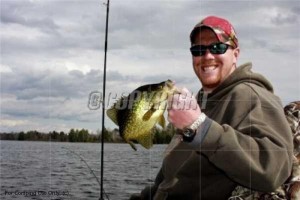How to catch fish with the Rapala Clackin Rap , a crankbait that does not have a lip. An overlooked method when it comes to walleye and bass. The Clackin Rap is a new bait just a few years old. It has no lip, it is large, heavy, and sinks. What is really unique about the Clackin Rap is it 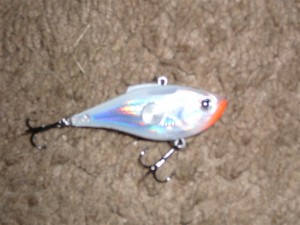 has large rattle chamber with one big BB. The Clackin rap is very loud and gives off big vibrations the fish can hear from a long distance away. Fishing the Clackin Rap rap you simply cast it (and it casts a mile because of its weight) you let sink to the bottom . If fishing walleye in a hard bottom environement simply give a steady retrieve. If fishing over weeds retrieve with rod tip high and let the lure work right above the weeds for bass and walleye. Try the Clackin Rap on weed edges , rock piles , sand bars etc. This is a presentation most walleye lakes have not seen. This gives you an edge. You can even troll the Clackin Rap or vertically jig the Clackin Rap for walleyes in deep water. If you are already using a crankbait such as the great rapala shad rap on your walleye lake. Try the Clackin Rap which will give off far more vibration and rattle many times triggering strikes that other baits would not. When cranking the Clackin Rap thru weed edges and you feel a weed jerk the Clackin Rap free of the weeds and let the lure flutter down before retrieving. Many times this ripping action will trigger a strike. There is no wrong you can fish the Clackin Rap. Try the Clackin Rap for walleye or bass. One draw back is yes the Clackin Rap is slightly more expenseive then your standard crankbait but not all that much more money.
has large rattle chamber with one big BB. The Clackin rap is very loud and gives off big vibrations the fish can hear from a long distance away. Fishing the Clackin Rap rap you simply cast it (and it casts a mile because of its weight) you let sink to the bottom . If fishing walleye in a hard bottom environement simply give a steady retrieve. If fishing over weeds retrieve with rod tip high and let the lure work right above the weeds for bass and walleye. Try the Clackin Rap on weed edges , rock piles , sand bars etc. This is a presentation most walleye lakes have not seen. This gives you an edge. You can even troll the Clackin Rap or vertically jig the Clackin Rap for walleyes in deep water. If you are already using a crankbait such as the great rapala shad rap on your walleye lake. Try the Clackin Rap which will give off far more vibration and rattle many times triggering strikes that other baits would not. When cranking the Clackin Rap thru weed edges and you feel a weed jerk the Clackin Rap free of the weeds and let the lure flutter down before retrieving. Many times this ripping action will trigger a strike. There is no wrong you can fish the Clackin Rap. Try the Clackin Rap for walleye or bass. One draw back is yes the Clackin Rap is slightly more expenseive then your standard crankbait but not all that much more money.
Matching The Hatch For Trout / How To Fly Fish (Part 1 )
How to fly fish. Matching the match. Turning over rocks in a stream you want to fish sand seeing what insect life is present is the start to match the
hatch. Most fisherment do not go far enough into the stream and they do not realize that most insect life when subject to the current come off the rock before it is sighted by the angler. Also many fly fisherman do not realize that different parts of the stream harbor different insect life. So what you really need to do is to go into the stream upstream where you are going to fish. Say your are fishing a pool and there are your typcal riffles upstream from that pool. Before you go into mid stream in these riffles and dislodge some rock. You need a piece of equipment called a kick net. A net with small mesh netting. Your going to place this kick net downstream where you are going to dislodge the rocks. Once the kick net is in place start dislodging rocks. Observe what is on the rocks and take a few back to shore along with your net contents. Put the net contents into a white tub. This will make viewing the screen contents easier. Once viewed you will match to a selected fly you will fish. We will cover how to select a fly to fish in another upcoming post.
How To Fly Fish / How To Fish A Streamer / A Neglected Method For Trout (Part 1 )
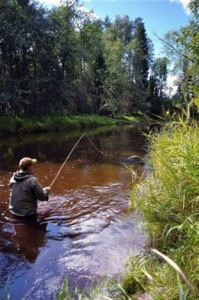 A forgotten and a neglected method for catching trout in streams is using a streamer. Most trout fishermen like to use a dry fly , nymph, worm, or a spinner. Why the streamer is not more popular is hard to say, but it certainly is a very effective way to take trout and particular the very biggest trout in the system. A streamer is a bigger type of fly that sinks slowly and imitates a minnow instead of an insect. You fish streamer in your deep holes of the stream. These deep holes harbor the niche where the biggest trout in the stream live. These bigger trout prefer to feed on minnows (even their own kind trout minnows)instead of the smaller insects. This higher protien diet gives the fish greater size. How to fly fish a streamer. To fish a streamer start in your deeper holes and at the downstream end and work your way upstream to the head of the pool. Keep a low profile to avoid spooking the fish. Fancast the streamer , count down to different depths. In working the streamer , keep the streamer moving , use twitches to mimic a wounded minnow, do not slow down but keep the streamer moving. Do not keep any slack in your line. It is importatant to work different depths , right to the bottom. For a leader use 6 pound line. We are not going to mess around when one of these bigger trout take the streamer. Play the fish use the bend of the rod to let the fish tire. Once you net the fish release as quick as possible. One thing thats exciting when fishing streamers is the fish seams to come out of no where when it it takes the streamer. The streamer fishing is an exstreamly exciting way to fly fish. You know when you get a fish it is likely to be one of the bigger fish in the stream. Again the streamer is not used by most trout fisherman. This gives you the edge at presenting a bait that the fish have not seen. Next tine try the streamer . It will help you catch more fish.
A forgotten and a neglected method for catching trout in streams is using a streamer. Most trout fishermen like to use a dry fly , nymph, worm, or a spinner. Why the streamer is not more popular is hard to say, but it certainly is a very effective way to take trout and particular the very biggest trout in the system. A streamer is a bigger type of fly that sinks slowly and imitates a minnow instead of an insect. You fish streamer in your deep holes of the stream. These deep holes harbor the niche where the biggest trout in the stream live. These bigger trout prefer to feed on minnows (even their own kind trout minnows)instead of the smaller insects. This higher protien diet gives the fish greater size. How to fly fish a streamer. To fish a streamer start in your deeper holes and at the downstream end and work your way upstream to the head of the pool. Keep a low profile to avoid spooking the fish. Fancast the streamer , count down to different depths. In working the streamer , keep the streamer moving , use twitches to mimic a wounded minnow, do not slow down but keep the streamer moving. Do not keep any slack in your line. It is importatant to work different depths , right to the bottom. For a leader use 6 pound line. We are not going to mess around when one of these bigger trout take the streamer. Play the fish use the bend of the rod to let the fish tire. Once you net the fish release as quick as possible. One thing thats exciting when fishing streamers is the fish seams to come out of no where when it it takes the streamer. The streamer fishing is an exstreamly exciting way to fly fish. You know when you get a fish it is likely to be one of the bigger fish in the stream. Again the streamer is not used by most trout fisherman. This gives you the edge at presenting a bait that the fish have not seen. Next tine try the streamer . It will help you catch more fish.
Walleye Jig Fishing Techniques (How To Catch Walleye)
How to catch walleye using the jig. The jig is the most versatile lure. If forced to choose only one lure to fish with the majority of the fisherman would choose a jig. There are so many ways to fish a jig (from trolling to casting to fishing the weeds. For walleyes there are several factors to
consider when fishing a jig to up your odds in being successfull. The walleye is generally found most of the time right near the bottom. Tip one use as light a jig as you can. For instance if it is a calm day you may want to fish a 1/8 oz jig. If it is windy you may want to use a 1/4 oz 3/8 oz or even 1/2 oz jig (if your fishing deep water or river fishing where there is strong current). Your guide is to use the lightest jig to get you to the bottom. Jig color can be very important. Switch colors and let the fish tell you what they prefer. Good basic colors are yellow , green, orange. Tip your jig with a minnow, part of a night crawler , leech, or one of the superbaits such as the gulp alive 4-5 inch shad. Retrieve the jig can be done by slowly crawling the bottom or many like to pump the rod a little then reel in slowly and pump the rod again. You can also try a jig type that has a little spinner in front of the head for more action. For equipment use a medium action graphite rod 6-7 ft with a soft rod tip. For line use 6-8 pound Floro carbon. The floro carbon line will help you feel those soft bites. It will definitely up your odds in catching more walleye. Another advantage of floro carbon is its invisible prpoerties. Try these tips to help you catch more walleye.
How To Fly Fish Presenting a Dry Fly (Part 1 The Basics).
How to fly fish a dry fly. For those that do not know a dry fly is a fly that floats. A dry fly usually is the insect in it is adult form . Our goal when presenting a dry fly is to present a fly as naturally as possible to a trout. Postion yourself below the trout and off to the side, keeping a low profile so
http://youtu.be/oc2PQljqAXw
the fish will not see you. It is better to use short casts to avoid spooking the fish as opposed to long casts that may spook the trout. Use short false casts until the fly is ready to be put perfectly in the spot you want it placed , which is not to far in front of the fish. Fly fishing and the fly rod excells in spot on placement of dry flys. You should use an overhead cast . Your rod should travel in a distance approxiamtely 10 oclock behind you and 2 oclock in front of you. Use your wrist letting the rod bend and power the line back and forth as you let out line in your false casts. You pause as the line reaches and extends the full distance behind and in front of you. Stop the rod at 10 and 2 oclock positions, stripping off line to where you have enough to make your final cast. Do not whip the rod. When you finally cast the dry fly it should float at the same speed as the foam on the water. Watch the fly closely for a strike. When the fish strikes the lure wait a few seconds then set the hook. This gives the fish time to swallow the lure so it can be hooked. How to catch fish with a dry fly is a must for the fly fisherman. Dry fly fishing for trout is very enjoyable.
How To Catch Walleye Using Live Bait Rig (Part 1 the Basics)
How to catch fish (walleye) using a live bait rig. The live bait rig is a bread and butter system for walleye fisherman. Especially in Minnesota. The live bait rig has 3 components: 1) A hook size #6 in most cases. 2) A barrell swivel. 3) A lead weight from 1/4 oz to 3 oz. You rig a live bait rig by
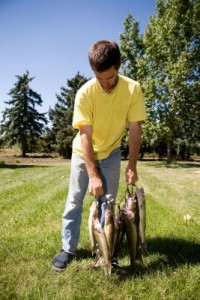 putting the sliding sinker on your fishing line and tying a barrell swivil to the line. The sinker cannot slide off the line but can go up and down the line. To the opposite end of the barrell swivel tie a leader . A flouro carbon leader in length of 4 to 8 feet. On the end ofd the leader tie your number 6 hook. Equipment for live bait rigging use a medium action 7 Ft rod. Put a minnow or leach on the hook and you are ready to fish. Lets start fishing as an example an edge of a rock pile in a range of 10-17 feet. You let your live bait rig drop to the bottom directly below the boat. Using a spinning reel with the bail open and your finger on the line start backtrolling. You feel the sinker on the bottom lifting the rod tip up and down slightly to make sure the weigth is on the bottom. As you troll say starting at 10 feet to 17 feet you let the line off your finger until you feel the weight hit the bottom. Then put your finger back on the line so no more line goes out. You are fishing nearly vertical to the boat If you feel a slight snag immediately let your finger off the line. Give it 15 to 20 seconds. Keep the rod tip up and start reeling, when you feel the weight of the fish set the hook. The adavantage of the live bait rig are the following : 1) A very natural bait presentation. 2) Precise control fishing nearly veritical below the boat on the structure you see on your depth finder. 3) When you feel a hit you can give the fish line that has no resistance. The live bait rig is especially good for very finicky biters on high pressured waters. Try the live bait rig if you have not already to help you catch more fish.
putting the sliding sinker on your fishing line and tying a barrell swivil to the line. The sinker cannot slide off the line but can go up and down the line. To the opposite end of the barrell swivel tie a leader . A flouro carbon leader in length of 4 to 8 feet. On the end ofd the leader tie your number 6 hook. Equipment for live bait rigging use a medium action 7 Ft rod. Put a minnow or leach on the hook and you are ready to fish. Lets start fishing as an example an edge of a rock pile in a range of 10-17 feet. You let your live bait rig drop to the bottom directly below the boat. Using a spinning reel with the bail open and your finger on the line start backtrolling. You feel the sinker on the bottom lifting the rod tip up and down slightly to make sure the weigth is on the bottom. As you troll say starting at 10 feet to 17 feet you let the line off your finger until you feel the weight hit the bottom. Then put your finger back on the line so no more line goes out. You are fishing nearly vertical to the boat If you feel a slight snag immediately let your finger off the line. Give it 15 to 20 seconds. Keep the rod tip up and start reeling, when you feel the weight of the fish set the hook. The adavantage of the live bait rig are the following : 1) A very natural bait presentation. 2) Precise control fishing nearly veritical below the boat on the structure you see on your depth finder. 3) When you feel a hit you can give the fish line that has no resistance. The live bait rig is especially good for very finicky biters on high pressured waters. Try the live bait rig if you have not already to help you catch more fish.
How To Fly Fish / How To Read Trout water (the basics)
How to fly fish. To read a trout stream we will break down the stream into three components: 1) Riffles. 2) Runs 3) Pools. A riffle is your fast shallow water in a trout stream . It is about ankle deep. A riffle can harbor a lot insect life. A riffle is like a feeding belt carrying food at a fast clip to other parts of a
trout stream. The riffle as you go down stream leads into a run. A run is deeper and slower water then a riffle, The run continues to carry food downstream. Going downstream from run you will eventually leads into a pool. A pool is the deepest part of a trout stream and will hold the biggest fish. Alright how do start fishing the riffel, run , pool? With trout fishing always start downstream and work your way upstream. We will start at the very bottom of the pool. When you approach the very end of the pool keep a low profile , even kneeling down so the trout will not see you or your shadow. Fan cast the pool letting your fly or nymph drift downstream. Slowly and stealthly move upstream in the pool until you have fished the pool. You them do the same with the run. Staring at the head of the pool and the end of the run you work the run in the same method you work the pool. Fancast the run and keep moving upstream. When you get to the riffles you do the same. Keep working upstream until the end of the riffle. What to use. Match the hatch . simply turn over the rocks and note the insect life. Also observe in the stream what is hatching. Reading the trout stream will help you learn how to catch more fish.
Heddon Sonar Great Forgotten Lure For Walleye / How To Catch Walleye
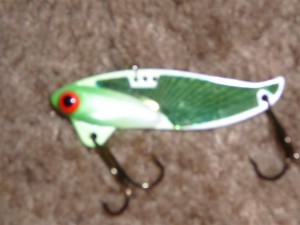 How to catch walleye using the Heddon Sonar. An excellent deadly lure for walleyes Is called a Heddon Sonar . This lure has been around since the 1960-1970’s and was a very popular lure for fishing rivers. Today the Heddon Sonar is forgotten by many walleye fisherman and kept as a secret bait by other walleye fisherman. For those
How to catch walleye using the Heddon Sonar. An excellent deadly lure for walleyes Is called a Heddon Sonar . This lure has been around since the 1960-1970’s and was a very popular lure for fishing rivers. Today the Heddon Sonar is forgotten by many walleye fisherman and kept as a secret bait by other walleye fisherman. For those
not familar with this lure. It gets its name from sonar from the extreme vibration that this lure gives out when fishing it. Picture a flat metal lure shaped like a minnow with The 3 holes in the middle of the back of the lure for line attachment. The three line tie holes allow adjustment of the lure’s running depth and action. The front hole is for shallow running and high vibration. The rear hole produces deep running and a wide, slower, wobbling action. The center hole is can be used for jigging. It can be fished verticaly over schools of walleye like an ice fishing jig. Try casting and fishing the sonar like you would a crank bait. Cast the sonar on shallow rock beds or sandbars. Also try casting the sonar parallel to a the deep weed line (like you would a crankbait). The sonar is an excellent muti-specie bait. When you spot a school of walleye that is reluctant to bite using live bait rigs or other methods. Try using a marker bouy then vertically jig the sonar over them. Drop the sonar to the bottom (if the school of walleyes is on the bottom) and lift up with the rod about a foot. You will feel the strong vobration this lure gives out. Let the lure fall back to the bottom and repeat. Vary how fast you jig the sonar up to match the mood of the walleyes. If the walleye are in a nuetral feeding attitude you will jig the sonar slower then if they were in a positive feeding mood. Do not forget to try the Heddon Sonar for trolling. It has a heavy weight so the Heddon Sonar sinks like a jig, yet when trolled gives off a flutter and a strong vibration. The walleye that are used to seeing live bait rigs and crankbaits have not seen this lure type action. Try the Heddon Sonar to help you catch more walleye.
How To Fly Fish for Bass
How to fly fish for bass. Have you ever considered fly fishing for bass? If you haven’t why not give it a try?. Fly fishing for bass is fun! Pure and simple. Why do you ask you should you fly fish for bass other then fun? Well there are several answers. Fly rod fishing for bass is at its best when
fishing the shallows , the junk. Fishing lily pads , stumps, milfoil, docks etc. When accuracy is neeeded the fly rod excels. A good fly fisherman can lay a fly or a popper on the same open spot (say in the weeds) time and time again. Anoter big advantage is on calm days when the surface is flat a fly fisherman can cast a fly out on the water with minimal splash. The fly fisherman will catch fish that would other wise spook when using other equipment (such as using a spin cast with a frog or mouse). What kind of equpment is involved for fly fishing for bass. A 8 1/2 foot rod that is graphite is ideal. Use a 8-9 weight fly line and a 15 pound leader. For reels just grap your normal trout rod & reel sto start. To get a reel that is specialized for bass get one with a disc type drag. For lures. I like poppers large cork or balsa poppers with feathers. Flys that are good for bass are the muddler minnow and the Jansens minnow. How do you fish the poppers and flys. Let the fish mood dictate the retrieve. When the bass are in a negative or nuetral mood use a slow pop and stop . When bass are active use a fast non predictable retrieve. Try fly fishing for bass it is indeed a blast and will help you catch more fish.
Small Crankbaits For More Crappie / How To Catch Crappie
How to catch fish with a small crankbait. Try this method . Take the very smallest crankbait such as the 1″ rapala and use it. It is a great multi specie bait. It works through out the year. In my opinion it is at its best on the deep weedline during the summer. These small crankbaits run 3-5 feet
under there surface. It is a great search bait. You cover a large amount of water quickly. Your just as apt to catch a bass walleye , northern pike or nice panfish. Many times the fish (bass, walleye , crappie) prefer the smaller crank bait as opposed to the larger ones such as a number 5 or 7 which is too large too catch your crappie most of the time. Once you locate some crappie with the small crank bait you might want to through out a marker bouy and work the area with a slower presentation such as a 1/32 once jig and minnow or jig and super bait minnow below a bobber. Or if you catch a couple walleye mark the spot with a bouy and try a jig and minnow without a bobber . The small crankbaits are good when working sandbars or shallow rocks. Another tip if you see bait fish rising to the surface there is likely a school of fish hearding the bait fish to the top. When you see this condition grap your rod rigged with the small crankbait. I recommend a light or medium action rod with a spin cast reel with 6 pound test. Tie your line directly to the crank bait for the best lure performance. Try small crank baits for catching mor crappie and bass. You just do not know what you are going to catch and thats what makes fishing these lures so fun!
 Pictured right small crankbait
Pictured right small crankbait


